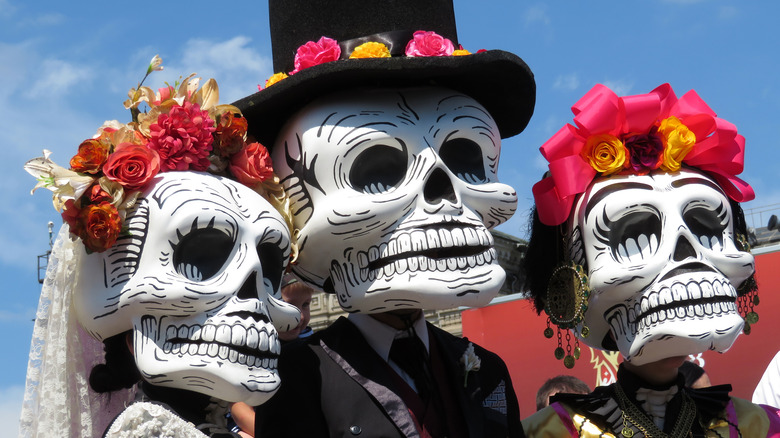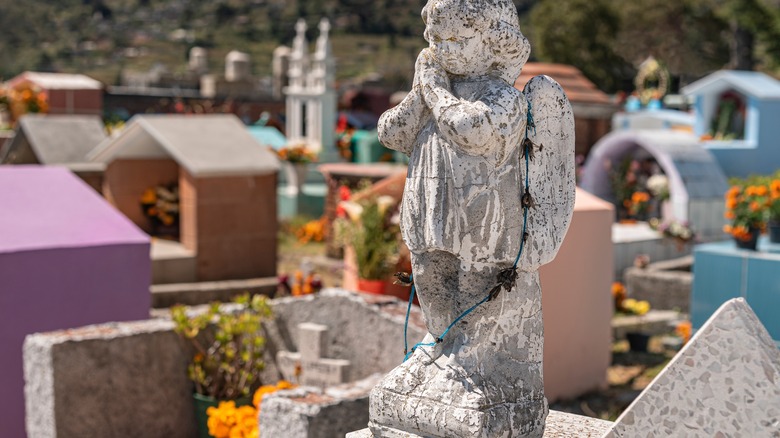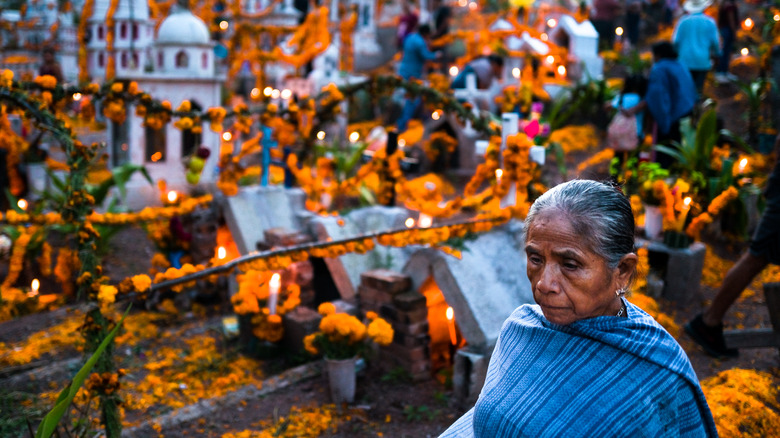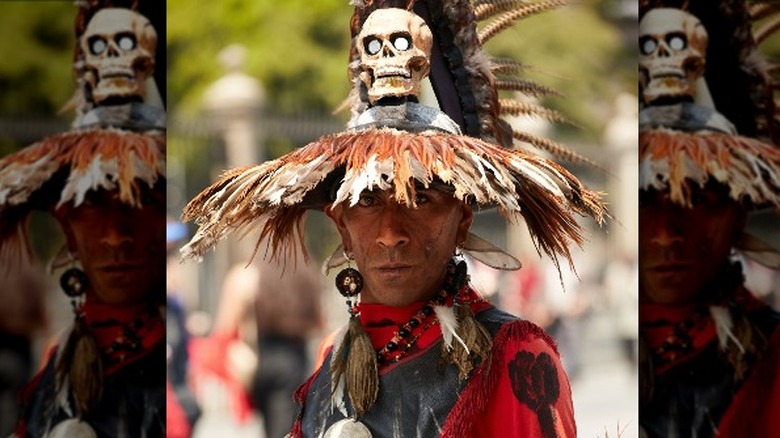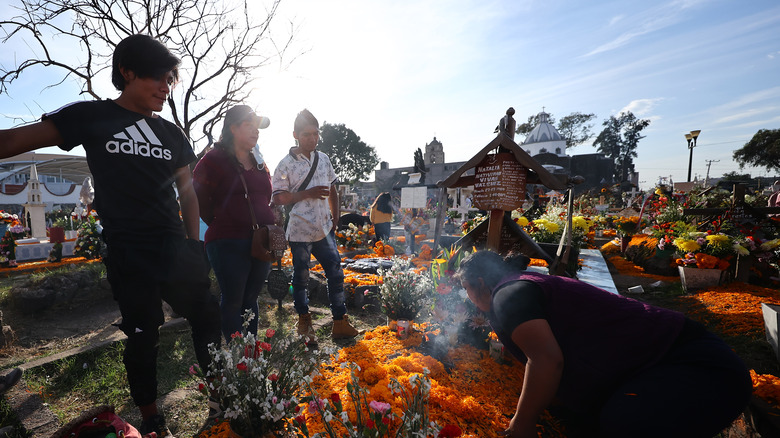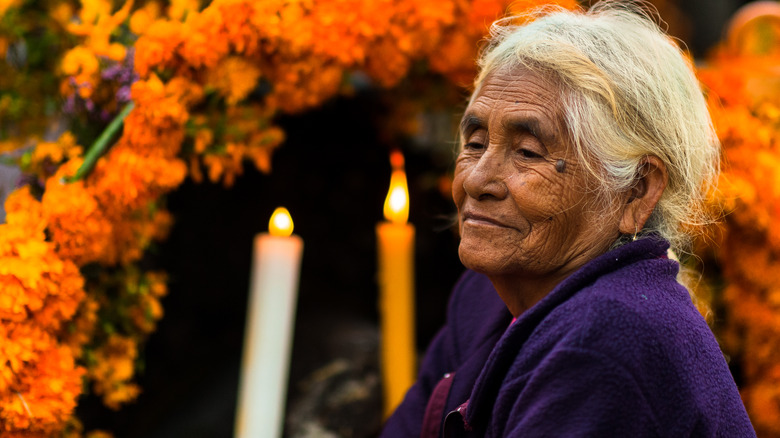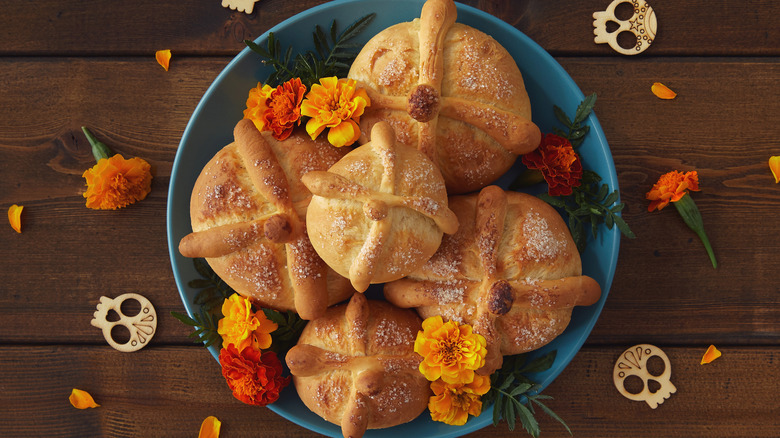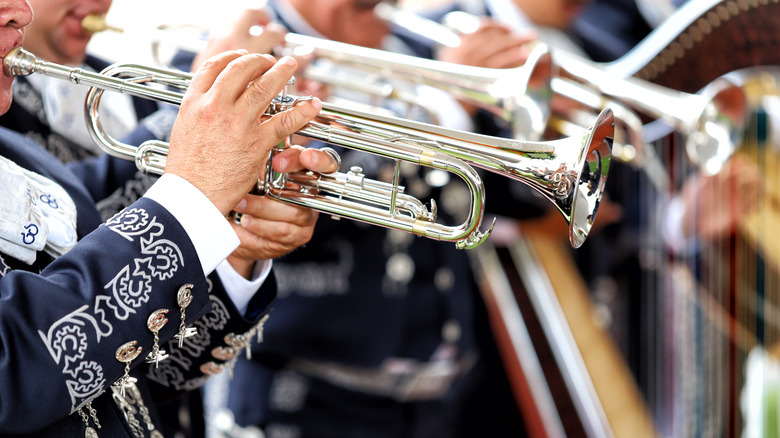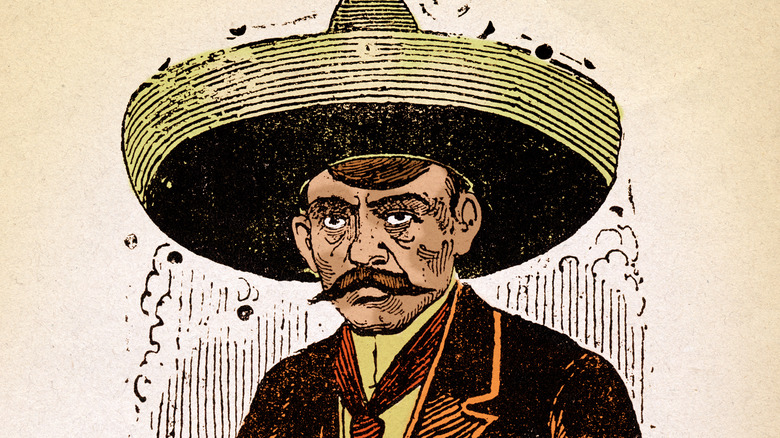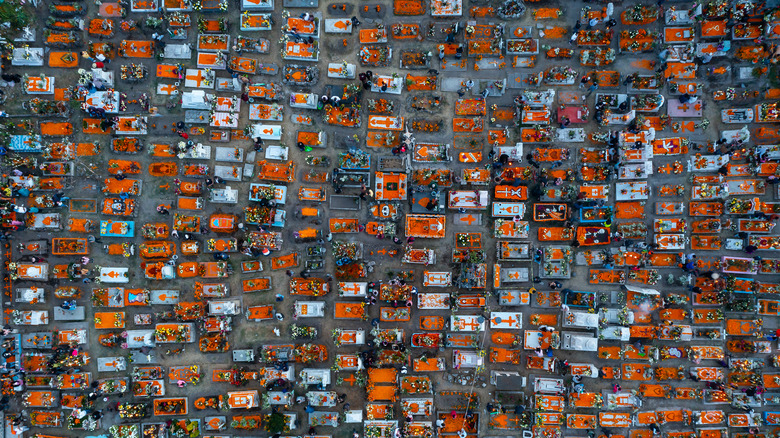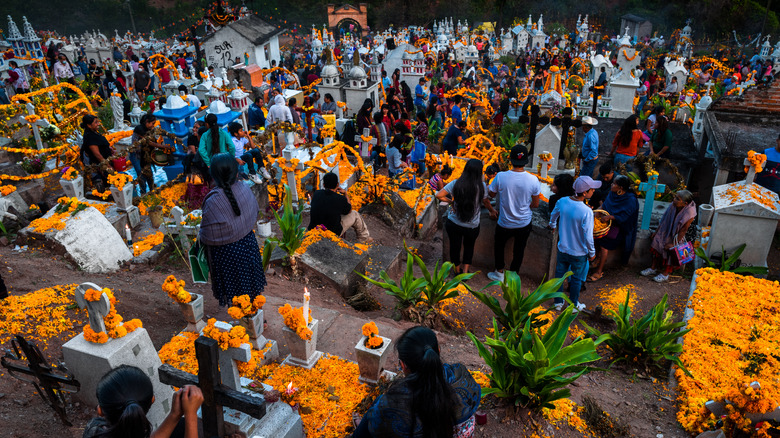Day Of The Dead: Your Guide To The Holiday
In recent years, Hollywood has given the public fascinating, colorful takes on Mexico's Day of the Dead. In 2015's "Spectre," James Bond must navigate a vibrant parade of costumed people to complete his mission of assassinating some really bad guys. Of course, things don't go quite as planned, but the stunning costumes and rich cultural atmosphere is undeniable. Besides live flicks, animation has given us some unforgettable perspectives on the holiday, too.
Guillermo del Toro and Jorge Gutierrez plumbed this fertile ground in 2014's "Book of Life," creating a festive story chock full of imagery from the holiday, including the very recognizable calaveras (skulls) and calacas (skulls). And 2015's "Coco" delves into the traditions and beliefs associated with this holiday while providing a unique child's perspective on the festivities and commemorations.
That said, these depictions in film only give us part of the story when it comes to Day of the Dead. For example, the holiday is celebrated in more parts of the world than Mexico, and it includes many surprising elements that many people outside of Latin America know very little (if anything) about. Here's the inside scoop on Day of the Dead.
It's more than a day
With a name like "Day of the Dead," Mexico's most iconic holiday should only last for 24 hours. However, the observance stretches from October 31 through November 2, providing ample time for locals to participate in parades, festivities, music, and family-centered observances (via the University of New Mexico).
Part of the reason for the prolonged festivities has to do with the many forms commemoration and remembrance of the dead may take. According to UNESCO, deceased individuals get honored at different times and in disparate ways depending on various factors, including the age when they died, the cause of death, the profession they held in life, and more. In other words, if you're tempted to travel south of the border to experience the holiday, prepare for multiple days of celebration. For this reason, you'll sometimes hear locals refer to "days of the Dead."
October 31 is celebrated as All Hallows Eve (or Halloween), and then November 1 marks All Saints Day (known alternately as Day of the Children or Day of the Little Angels). Last but not least, November 2 is known as All Souls Day (or Day of the Dead), and this is the part of the festival people outside of Latin America are often most familiar with. Interestingly, these days coincide with the nation's massive corn harvest. As a result, it's believed observing Day of the Dead rituals with great care contributes to better corn harvests.
It includes a day dedicated to kids
Day of the Dead ushers in the return of the deceased to the world of the living, according to Access to Culture. In this sense, it's similar to Halloween in the United States, per History. Unlike Halloween, though, the dead are warmly welcomed back rather than scared away with jack -o'-lanterns, per Britannica. Celebrants go the extra mile to make their communities welcoming to the non-living.
According to tradition, the deceased return in various waves based on their ages (via Eiteljorg Museum). Children who passed prematurely reappear on November 1 for Day of the Little Angels. Mexico's indigenous peoples have long believed that youth who die prematurely enter the Afterlife without blemish. As a result, their souls are immediately transfigured into angels.
To prepare for this wave of spirited youngsters, the families of deceased children gather on October 31, creating an altar or ofrenda decorated with the child's favorite things. Decorations include banners made of paper, balloons, toys (both well-beloved by the child in life and new), and piles of candy. In some parts of Mexico, living children dress up in costumes and head out for something reminiscent of trick-or-treating called Mi Calaverita (My Little Skull). Families also participate in the Vigil of the Little Angels. Led by the women of the family, this involves taking living kids to the cemetery to remember those no longer with them, per Mary Andrade's "Day of the Dead, A Passion for Life."
Celebrations involve grave maintenance
Day of the Little Angels isn't the only time families visit the cemetery, per the University of Mexico. Deceased adults don't show up until November 2, which translates into more time spent at gravesites. Some of the activities associated with Day of the Dead have cropped up for practical reasons. Cemeteries aren't privately owned in Mexico, and so the entire community cooperates in their upkeep. The "days of the Dead" provide ample opportunities to tidy up.
While visiting the graves of loved ones, family members use the time to pull weeds and straighten things up. After all, it wouldn't do for the dead to return only to find their graves poorly kept and in disrepair. The cemetery activities don't stop there. Families bring picnic lunches with them and enjoy meals in the presence of their ancestors. These extended family get-togethers involve singing and telling stories as families reminisce. Despite the bittersweet nature of the holiday, it's important that participants stay cheery and festive because it's believed that mourning and sadness represent an affront to the non-living.
According to History, families also decorate the gravesites of their loved ones with their favorite food along with common items such as tequila, water, chiles, tamales, and pan de muerto (bread specific to the holiday). Twinkling candles light up photographs of the deceased, and incense and flowers fill the air with fragrance, enticing the dead homeward. At dusk, these glittering decorations transform cemeteries into luminescent dreamscapes.
It boasts ancient roots
It's tempting to assume that Day of the Dead is a relatively new holiday. After all, Halloween didn't really take root in the United States until the mid-19th century (per History), and it's still not a national holiday (via the Sacramento Business Journal). But Day of the Dead has ancient roots, stretching back three millennia, per AZ Central!
The celebration remains most closely associated with the Pre-Columbian Aztec Empire, which flourished between the 13th and 16th centuries near present-day Mexico City, according to History. The Aztecs held various ceremonies throughout the year that paid homage to those who went before. During these special days, imagery still associated with Day of the Dead first became iconic, including skulls, which were used to decorate their temples, as reported by History. Today, these ghastly symbols take a far less macabre form as sugar skull confections.
The Spanish, under the leadership of Hernán Cortés, conquered the Aztec capital of Tenochtitlan in 1521, per History. As the Spanish and indigenous cultures mixed, religious syncretism took place. The Aztec calendar contained many dates throughout the year that honored the dead. To accommodate Christianity, these indigenous dates were concentrated and juxtaposed onto the Catholic calendar at the beginning of November, which already held commemorative days to the deceased and saints. Over the centuries, Day of the Dead continued to evolve, borrowing both indigenous and Catholic imagery to create a cohesive festival.
Today's holiday is multicultural
Because of religious syncretism, today's Day of the Dead represents a multicultural festival, according to the University of Albany. Its blend of indigenous and European cultural influences have resulted in a vibrant and dynamic tradition that continues to grow in popularity and worldwide influence.
Yet, a misnomer still exists that Day of the Dead is specifically (and solely) a Mexican holiday. But this couldn't be further from the truth. In reality, it has been celebrated throughout Latin America for centuries (via the Berkley Center). And the same goes for the United States, especially when it comes to regions once controlled by Mexico or where large Mexican communities have traditionally lived. Whether you're in Peru, Argentina, Columbia, Guatemala, El Salvador, or the Southwestern United States, don't be surprised to see people dressed as skeletons or hanging out in cemeteries at the end of October and beginning of November.
You could also make the argument that the holiday is multi-religious. After all, it contains an admixture of sacred symbols, elements, and concepts from Catholicism and the pre-Catholic traditions of Latin America. As History reports, the burning of copal incense dates back to pre-contact Mesoamerican practices, as does decorating skulls. According to an article from Current Anthropology, ancient, embellished skulls had inlaid eyes, blades placed in the nose, and were often covered with dye. The Aztecs used these gruesome art pieces as headdresses worn over their faces.
Despite the name, it celebrates life
With a name like "Day of the Dead," it would be understandable to assume the entire thing's a macabre celebration of death, but that's a clear misread of the vibe, as the University of New Mexico explains. Sure, the holiday emphasizes the fleeting nature of the human experience, but it also urges participants to savor the present and acknowledge those who have gone before.
These are universal themes that humanity can get behind, which might also explain some of the vast popularity of the holiday. If you had to sum its theme up in two words, they'd be "carpe diem" (seize the day), per Britannica. Participants in the tradition have a lot to say about its impact on them, as reported by AZ Central.
Ken Schutz has vivid memories of the annual experience. While he found the visits to the cemetery among the stranger aspects of the holiday, this also had a long-term impact on him. In retrospect, he states, "To me, it was the most culturally unfamiliar part of the experience: To sit in a cemetery all night with a mariachi band and a picnic basket at the gravesite. The whole thing — it's a whole different way to look at what it means to be alive. It was life-changing for me." Beneath the colorful costumes, sugar skull sweets, and other visible facets of the holiday is a much deeper meaning with lessons people carry for a lifetime.
Day of the Dead indulges foodies
Day of the Dead has the feel of a joyful celebration, and that means plenty of food (via the University of New Mexico). Not only do the living partake in delish recipes, but the favorite foods of dead relatives are lovingly prepared by the living and then placed on altars dedicated to them.
According to Mary Andrade's "Día de Muertos en México," the concept of deceased family members returning for a visit is both visceral and tangible. This is exemplified by a prayer offered with the food (including pan de muerto) at altars: "We bring you these gifts, we know that you will not eat it, but you will take with you the essence of this bread, of this fruit which we are giving to you, you shall savor it first but then, so shall we."
One of the sweet treats most widely associated with Day of the Dead are calaveras de azúcar, or sugar skulls. These tiny, decorated skulls may represent a shoutout to the macabre decorated headdresses of the Aztecs (via Current Anthropology). But the sweetness of the desserts also alludes to "how sweet life is," as reported by McCormick. For all the foodies out there, calaveras de azúcar are a confection made from simple yet tasty ingredients that melt in the mouth: meringue powder, sugar, and water.
Cemeteries get boisterous
Besides tidying up the gravesites of loved ones, participants in Day of the Dead spend the night at the cemetery, per AZ Central. Some take it a step further and spend two nights there. During their stay, they indulge in delectable treats, mezcal, and tequila accompanied by the music of mariachi bands. During these festivities, family members reminisce about lost loved ones, tell stories, and spend quality time together.
Looking back on celebrating Day of the Dead in his childhood, Gennario Garcia remembers the strange contradiction of spending the night in the cemetery partying. He explains, "Part of our tradition in Mexico is to not be scared of death and to smile at it. It's a celebration of our ancestors as they were when they were on this earth, alive. It was never a sad thing or a scary thing."
This stands in polar opposition to traditions in other parts of the world. For example, Mexican immigrants to the United States have encountered problems carrying on some of these traditions in their new home, per USA Today. After all, cemeteries aren't considered places of boisterous celebration, and many aren't open for 24-to-48-hour camp outs showcasing mariachi bands and tequila shots. Add to this the tradition in some parts of Latin America that involve live music to remember the dead, and you've got something difficult to observe stateside, as reported in Mary Andrade's "Day of the Dead, a Passion for Life."
The Mexican Revolution boosted the holiday
During the Mexican Revolution, more than 1 million Mexicans died, making it the deadliest conflict in the New World, according to El Universal. These losses occurred in little more than a decade, and they left survivors reeling. As Mexico faced national mourning, the trauma associated with the conflict enhanced the relevance of Day of the Dead, leading to a spike in popularity heading into the 20th century.
In essence, Day of the Dead paved the way for national healing, and it also embraced the "dance of death" theme that had come to mark life in Mexico during those war-torn years, as argued by the University of Albany. With so many people to welcome back to the land of the living once a year, Mexicans embraced Day of the Dead and its festivities with an unprecedented enthusiasm.
One of the artists most closely associated with the festivities today remains Jose Guadalupe Posada, who lived during the early years of the Revolution. A political satirist, he used the calaveras (skeleton) figure to satirize everything from governmental corruption to class conflict. His imagery remains a potent symbol of everything the holiday stands for, including the tangible reality of the Great Equalizer: death. It comes for all people on the planet, from the poorest to the richest and everybody in between.
It's bigger than Christmas
When it comes to holidays in the United States, it's hard to rival Christmas. From Hallmark movies to department stores chock full of decorations, many Americans get fully invested in this holiday and its traditions. So do retailers who make a huge chunk of change during the holiday season (via Finical Holdings).
However, all bets are off in Mexico. There's no other religious holiday that's as big as Day of the Dead, including Christmas, according to the University of Albany. Besides food and assembling in cemeteries, celebrants partake in massive parades filled with large sculptures of papier-mâché. And it's easy to see where the appeal of the holiday comes from. After all, it addresses the big issues of life that every human being has to wrestle with at some point in their existence.
What's more, Day of the Dead is both a celebration that communities across the nation share in and a highly private experience, with many of its activities and remembrances taking place within the family home. As the largest religious holiday observed in the nation, it offers something for everyone, uniting communities in powerful ways.
It's not Mexican Halloween
While European influences exist on Day of the Dead, you can't chalk it up as the Mexican version of Halloween or All Hallow's Day, per Missouri Life. Not only does this misrepresent the cultural meaning and attributes of the festival, but it also ignores the many millennia of history associated with the holiday (via McCormick).
Day of the Dead has become synonymous with Mexican identity, according to UNESCO. But it also has international appeal, underscored by UNESCO's decision to add it to the list of Intangible Cultural Heritage of Humanity assets in 2008. As UNESCO's website explains, "This encounter between the living and the dead affirms the role of the individual within society and contributes to reinforcing the political and social status of Mexico's indigenous communities."
Although Americans tend to focus on the more ghoulish aspects of Day of the Dead, among its most vibrant and obvious symbols are marigolds and butterflies, as explained by National Public Radio (NPR). The sweet fragrance from these golden flowers accompanied by monarch butterflies are thought to entice and lead the dead back to Earth. For this reason, they're a constant companion of "la ofrenda." This refers to the altars created by family members to commemorate their dead relatives and provide a place to leave offerings to them. Everything used to decorate the ofrenda has a symbolic or spiritual meaning, and they take months to construct and decorate, per Mary Andrade's "Día de Muertos en México."
